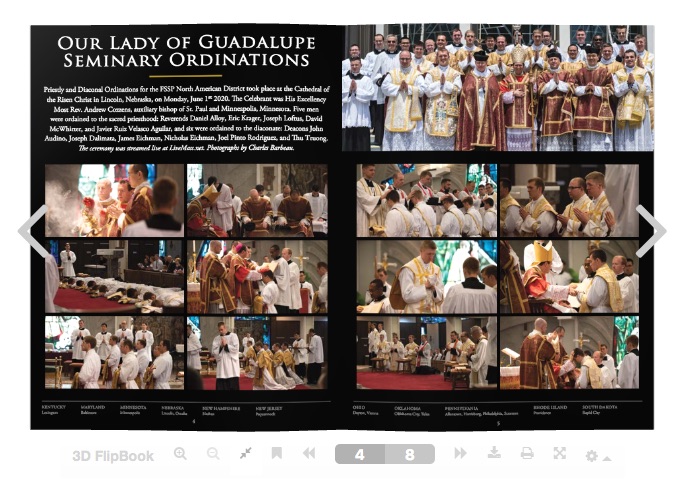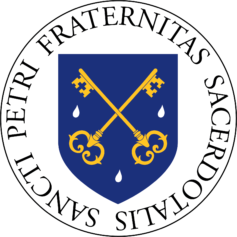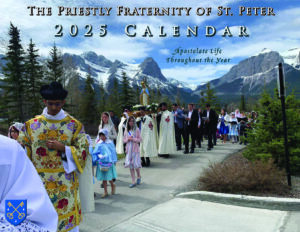FSSP Helps a Bishop Discover the Latin Mass
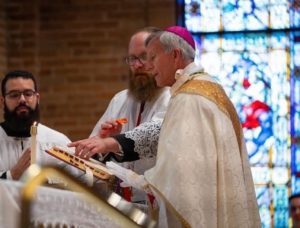 We are pleased to share a second FSSP-related National Catholic Register article this week: A US Bishop Discovers the Traditional Latin Mass.
We are pleased to share a second FSSP-related National Catholic Register article this week: A US Bishop Discovers the Traditional Latin Mass.
Bishop Joseph Strickland of Tyler, Texas was interviewed by the Register and goes into detail about what inspired him to celebrate his first Traditional Latin Mass on June 11, 2020:
Once the motu proprio was established and we were encouraged to make the Latin Mass available, we did this — his secretary was a FSSP [Priestly Fraternity of St. Peter] priest, so I know he was comfortable with the rite. He chose to bring the Fraternity to establish a little community here, and, again, it was very foreign to me. So, when they would approach the cathedral — and this sounds so pejorative now — I found myself often saying, “Oh, here come those people.” Of course I was encouraged to be welcoming and inviting as rector of the cathedral. They later would establish their parish, St. Joseph the Worker, and one of the very first things I did as bishop was to celebrate confirmation for them in Latin. That was a little different for me, celebrating a confirmation outside the Mass — as is done in the traditional rite. They joked my Latin had a Spanish accent!
What changed? What prompted you to learn the extraordinary form?
I’ve been bishop seven and a half years, and we do have priests and seminarians who have expressed interest in the extraordinary form, along with families — young families — participating, going to the Fraternity parishes. More and more, I found people expressing their desires to me to permit the Latin Mass — and, of course, I did, following the motu proprio. I found myself, more and more, becoming aware of the Latin Mass and the draw of the people to it, that it wasn’t this antiquated, negative thing that needed to stay buried.
His Excellency goes on to list some of the resources that helped him learn the traditional Mass, including the FSSP’s instructional YouTube videos.
He also shared a wonderfully emotional moment that happened to him during the Mass:
Just the beauty of the corporal and how the Host and the chalice are treated — I have to say [long pause, filled with emotion] I could hardly say the words of consecration because I became so filled with emotion, so deeply struck by those words. Thank God we only must whisper them in this rite, because I am not sure I would have been able to speak above that whisper, so struck I was at the profundity. It was the first time in my life that I had ever said those words in Latin, and I could hardly get them out. It’s indescribable, really.
Read the full interview at the National Catholic Register.
July 17, 2020

“They Have Been Waiting For You” – Oklahoma Confirmations 2020
by Lisa Lyhane
After disappointing delays due to the church shutdown, the parish of St. Damien of Molokai in Edmond, Oklahoma ushered in the month of the Sacred Heart of Jesus in a grand way when St. Damien’s pastor Fr. Simon Zurita notified the religious education catechists that Confirmation and First Holy Communions would take place. It did not take long to spread the exciting news that, after weeks of waiting, it was time for the girls to steam their white dresses and the boys to pull out their suits.
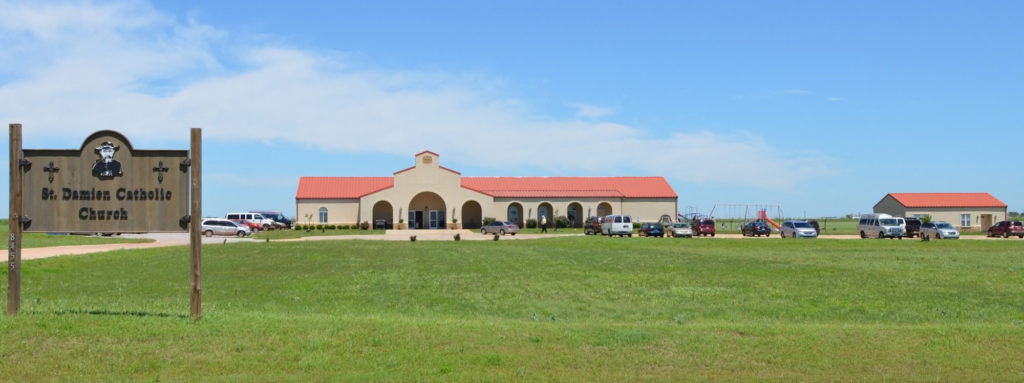
With a quick two-week notice, plans were set in motion to accommodate the Confirmation candidates, their sponsors and their parents in a space that had been reduced by half. Normally, a full church and a large indoor reception would follow, but this year, the good Lord would provide a perfect early summer evening, and on June 2nd, 2020, an excited group of 23 candidates were presented to His Excellency Paul Coakley to receive the Sacrament of Confirmation and to become soldiers of Jesus Christ. After the Confirmations took place, the confirmandi and their families spilled outside for pictures and a joyous reunion after having been separated since mid-March, when catechism classes were abruptly halted.
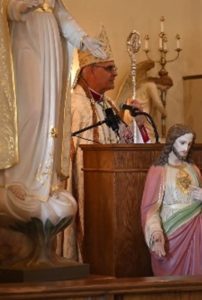
Confirmation season in the Oklahoma City Diocese keeps Archbishop Coakley busy every day during the spring, but with the church shutdowns this year, Confirmations were completely backed up. Confirmation catechist Terry Lyhane spoke with the Archbishop about this and found out that His Excellency had been able to administer the sacrament at his own Cathedral parish two days before and said that St. Damien’s was the second and the last Confirmation he would do this season, since he was just unable to go to the others due to the scheduling difficulties. He was giving the parish priests the permission to administer the sacrament in those parishes. St. Damien’s was deeply touched that His Excellency was able to do this for our parish, and as one of the attendees said to His Excellency, “The children have been waiting for this – they have been waiting for you.”
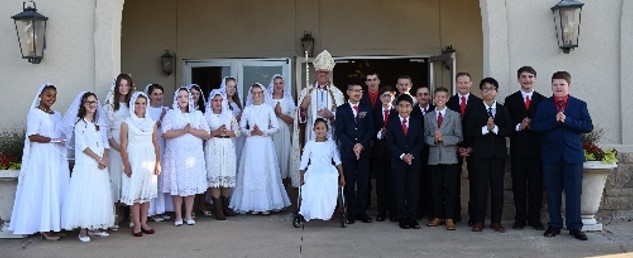
To take the sting out of not being able to have the usual refreshments, the confirmandi were treated to their very own “take-out” boxes of cupcakes, and each of them was presented with a plaque with their picture, along with a picture and short bio of their chosen patron saint.
The festive atmosphere continued through the first week of June, as a total of 17 children, who had been waiting for their Lord in the Holy Eucharist, were able to receive their first Holy Communion on Friday and Saturday, June 5th and 6th, 2020. First Communion Catechist Mrs. Janel Apel said, “it was very beautiful and such a treat to be in the church.”
After weeks of parking lot and on-line Masses, St. Damien’s parishioners are overjoyed to be back “in the church.” Father has added an extra Sunday Mass to accommodate us during this time, and the parish continues to grow with new faces every week.
St. Damien Catholic Church invites all those who are in the vicinity or just passing through to join us for daily and Sunday Mass at our location on 8455 NW 234th Street, Edmond, Oklahoma 73025. More information on the church can be found at www.saintdamiens.org.
July 16, 2020

NCRegister Interview with Fr. Killackey
Fr. John Killackey, FSSP of our Mater Dei apostolate in Harrisburg, PA was interviewed by the National Catholic Register after a photo of him in the rain was widely shared on social media.
“I would say to be a Catholic priest is to be another Christ, or just to try to be another Christ, at least as best as you’re able to, and in whatever circumstances God sends to you……So we live for Christ, and we try to bring him to other people. And that’s what the priest tries to do. His labor is for Christ and to do what he can to bring him to other people in all moments of life.”

The Missive interviewed Fr. Killackey this past February about his Path to the Priesthood.
July 15, 2020

Subseasons of the Time After Pentecost
With one stark exception, the liturgical seasons of the Roman Rite generally last from 2 to 6 weeks.
And this time frame certainly makes psychological sense. As any retail store marketer will tell you, it’s hard to keep people’s interest levels up without seasonality.
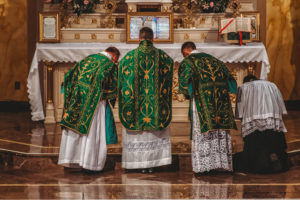 So what then are we to make of this long season after Pentecost…which grinds along in liturgical green for 24+ weeks–fully half the year?
So what then are we to make of this long season after Pentecost…which grinds along in liturgical green for 24+ weeks–fully half the year?
The key is seeing the seasonality within the season, the way Gaudete and Laetare Sundays sprinkle some joy into the prayerful watchfulness of Advent and the austere penance of Lent. And the way Passiontide gives a keener focus and renewed spirit to the end of Lent.
The Time after Pentecost was not always so uniformly defined or named. During the Carolingian Period, as we find in Alcuin’s writings, it was carved up into various subseasons pegged to the major feasts within it:
Post Pentecosten (after Pentecost)
Post Natale Apostolorum (after the birthday of the Apostles, from June 29th)
Post Sancti Laurentii (after St. Lawrence, from August 10th)
September (of the seventh month)
Post Sancti Angeli (after the holy angels, from Michaelmas on Sept. 29 to Advent)
In some places this general scheme lasted throughout the medieval period, with regional variations depending on which saints were especially honored in the area.
The Missal of Pius V did not adopt any of these named subseasons. Yet we can still detect some shifts in tone and emphasis from Pentecost to Advent, particularly when we also consider the readings from Matins in the Divine Office–the other half of the sacred liturgy.
As Dom Gueranger observed, the two objects presented to our consideration in the Time after Pentecost are “the Church and the Christian soul.” And they are presented with a certain flow that makes logical sense.
During the month of July, the Divine Office closely follows the Missal in keeping the ”Sundays after Pentecost” up until the Eleventh Sunday. And Matins during this period highlights the historical books: Josue, Judges, Ruth, and Kings—which give us a chance to contemplate how the history of the Jews foreshadows the growth of the Church after Pentecost.
But during August the readings in Matins no longer follow the Mass pattern of Sundays After Pentecost. They now switch to a monthly cycle: First Sunday in August, Second Sunday in August, etc., then First Sunday in September, and so on. (This monthly pattern will continue all the way to Advent, with different books of the Old Testament read during the weeks and months.) August also sees a shift away from the historical growth of the Church and towards the personal growth of the soul. The Matins readings are now taken up with the Sapiential or Wisdom books: Proverbs, Ecclesiastes, Wisdom, and Ecclesiasticus. In this period of late summer, roughly corresponding with the Missal’s 12th through 17th Sundays of Pentecost, we are in the fullest, most lush growth of the “green” time after Pentecost. The Mass texts continue to sound a consistent theme of right living.
But September brings another subtle shift. Gueranger sees this subseason as a practical application of August’s exhortations to wisdom: “Supernatural truth produces holiness, which cannot exist, nor produce fruit, where truth is not. In order to express the union there is between these two, the Church reads to us, during the month of September, the Books called Hagiographic; these are, Tobias, Judith, Esther, and Job, and they show Wisdom in action.” And note from these books how we are starting to see a more ominous tone creep into our consideration. The Scriptures cast us in with the Jews who face a series of threats to their very existence, whether from internal temptation as with Job, or from external enemies as with Judith and Esther.
This tendency becomes even more pronounced in the following month. Back to Gueranger again: “At the end of the world, the Church will have to go through combats of unusual fierceness. To keep us on the watch, she reads to us, during the month of October, the Book of Maccabees.” The Mass Introits have been drawing from the Psalms all year up till now, but beginning with the 18th Sunday after Pentecost, they draw from the Old Testament. Instead of prayers for assistance to live a righteous life, we see more prayers for peace, mercy, and deliverance from tribulation. We also see more Gospels that talk about the end of the world, and the tone begins to get more apocalyptic.
Finally we arrive at the Last Sundays after Pentecost—an unusual subseason that might seem to consist largely of liturgical filler: the intercalated Sundays. Though their readings are from the post-Epiphany Masses, however, it would be wrong to simply regard this time as a “catch-up” period without a distinct character of its own. In Gueranger’s words: “The near approach of the general judgment, and the terrible state of the world during the period immediately preceding that final consummation of time, is the very soul of the Liturgy during these last Sundays of the Church’s Year”. The Introit Dicit Dominus and the De Profundis at the Offertory are like an insistent drumbeat announcing the end of time. At Matins the readings are, appropriately, warnings from the Prophets: Ezekiel, Daniel, Hosea, and Micah.
We have thus reached the end of the liturgical year, and we have seen the whole history of the Church presented sequentially: birth at the Pentecost Octave, growth and maturity during August, the triumph of the saints during September, steadfastness in the face of persecution and oppression in October, and the end of the world in November.
So notwithstanding the invariant green vestments, the sacred liturgy presents different mysteries to us during summer and autumn, and following its lead will help us strengthen our endurance on earth and prepare for life in heaven.

The Apparitions of St. Kateri Tekakwitha
Extracted from the original account by Father Pierre Cholenec, from his Life of Katherine Tekakwitha (1696), one of the sources consulted in the canonization process. Cholenec was one of St. Kateri’s earliest biographers, along with Father Claude Chauchetiere who was her confessor and who reported the first appearance.
…
“Having spoken until now of Katharine’s life and death, we shall consider some apparitions that concern her, and of the extraordinary favors that several people obtained from heaven and receive daily in Canada through her intercession.” . . .
“The sixth day after Katharine’s death, that is to say, the Monday after Easter, a person of virtue and worthy of belief was praying at four o’clock in the morning, when Katharine appeared to him surrounded by glory, with majestic bearing and shining face lifted toward heaven as if in ecstasy. This marvelous vision was accompanied by three circumstances that made it seem more remarkable. In the first place, the vision lasted for two whole hours, during which this person could contemplate her at leisure and did so with a joy and a pleasure difficult to express, Katharine wishing by so marked a favor to acknowledge the great service she had received from him during her lifetime. Moreover this same apparition was accompanied by several prophecies, and by as many symbols which might be seen on both sides of Katharine in her ecstasy. Some of these prophecies have already been fulfilled, while others have not yet come to pass. . . .
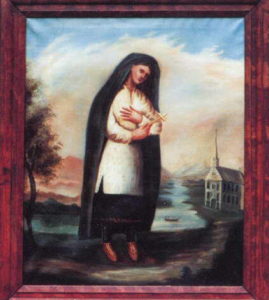
In the following year, 1681, on the first of September, and in 1682, on the twenty-first of April, this same person had a similar vision under the same circumstances, with this one difference, that in the first apparition he had seen Katharine as a rising sun, and had heard these words: Adhuc veni in dies, whereas in the two following he saw her as a sun in mid-heaven with these words: Inspice et fac secundum exemplar (Exod. 25:20), God thus making it known that He wished pictures to be painted of Katharine. For a long time we had refrained from doing so, but when they were painted later on they contributed a great deal toward making Katharine known, for, being placed on the heads of the sick, they brought about marvelous cures.
Two days after the first of these apparitions, Katharine appeared to the good Anastasia in the following manner.
This fervent Christian woman remained alone in prayer that night after the others of her lodge had gone to bed. Feeling herself overcome by sleep, she finally lay down on her mat to rest, but no sooner had she closed her eyes than she was awakened by a voice which called her with these words: “Mother, arise.” She recognized Katharine’s voice. Far from having any fear, she immediately raised herself into a sitting position, and turning to the place whence the voice came, she saw Katharine standing beside her, brilliant with light. Half her body was engulfed in this brightness, and the upper part was as bright as the sun. She carried a cross in her hand which was more brilliant than everything else, and from it there shone forth so much light that she thought there could be nothing more beautiful upon earth.
“I saw her,” she insisted, “in this position clearly, awake as I was, and I heard these words very distinctly: ‘Mother, look at this cross and see how beautiful it is. It was the source of all my happiness during my life, and I counsel you to make it yours also.’” After these few words she disappeared, leaving her mother overjoyed and with a spirit so filled with this vision that after many years her memory of it is as fresh as it was the first day.”
July 14, 2020

Lectures on Genesis by Fr. Dominic Savoie, FSSP
“An error in the beginning is an error indeed.” –St. Thomas Aquinas
Join Fr. Dominic Savoie, FSSP for a deep dive into the first chapters of Genesis using literary forms, Scriptural cross-references, Patristic commentaries, and works of art. In a refreshingly Catholic and scholarly manner, Fr. Savoie treats this difficult text with the humble respect it deserves, uncovering the imagery behind the words by careful consideration of how these passages have been understood and interpreted for the two millennia that the Bible was handed down.
All these lectures and even more great content are available on the FSSP Sacramento Youtube channel.
July 13, 2020

Afonso I: the Constantine of the Congo
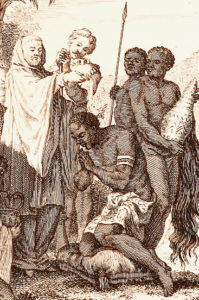 On June 4th, in the year of Our Lord 1491, a Congolese Prince named Nzinga Mbemba was baptized by Portuguese missionaries, taking the name of Afonso.
On June 4th, in the year of Our Lord 1491, a Congolese Prince named Nzinga Mbemba was baptized by Portuguese missionaries, taking the name of Afonso.
By 1509, his father the King of Kongo had died, touching off a war for succession that fractured the kingdom along a religious fault line. On the one side was the Catholic Afonso, and on the other his pagan half-brother Mpanzu a Kitima.
The two rivals met in a decisive battle at the capital of Mbanza Kongo, and what happened next is the stuff of Catholic legend. According to Afonso’s own account, his vastly outnumbered army appealed to St. James for assistance. The great Apostle then miraculously appeared in the sky along with five heavenly swordsmen, and the sight so frightened the pagans that their superior force broke and abandoned the field.
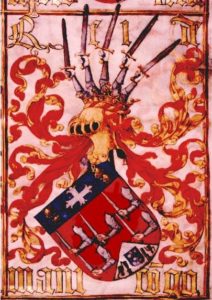 Afonso thus succeeded his father as Manicongo. Bolstered in his convictions by a wondrous act of divine aid, this Constantine of West-Central Africa did everything he could to shift the kingdom away from its traditional paganism and toward the Catholic religion. To commemorate his victory, he devised a coat of arms emblazoned with five sword-arms, the scallops of St. James, and broken idols. He made the feast of St. James a national holiday. He established Catholicism as the state religion of the Kongo, declared the worship of idols illegal, and burned a pagan temple. He encouraged the founding of confraternities, as well as missionary schools that instructed the Congolese aristocracy in Christian doctrine and in Latin. His son was even ordained a bishop by Pope Leo X. Afonso did so much to advance the Catholic faith during his reign that a contemporary Portuguese historian dubbed him “the Apostle of Congo.”
Afonso thus succeeded his father as Manicongo. Bolstered in his convictions by a wondrous act of divine aid, this Constantine of West-Central Africa did everything he could to shift the kingdom away from its traditional paganism and toward the Catholic religion. To commemorate his victory, he devised a coat of arms emblazoned with five sword-arms, the scallops of St. James, and broken idols. He made the feast of St. James a national holiday. He established Catholicism as the state religion of the Kongo, declared the worship of idols illegal, and burned a pagan temple. He encouraged the founding of confraternities, as well as missionary schools that instructed the Congolese aristocracy in Christian doctrine and in Latin. His son was even ordained a bishop by Pope Leo X. Afonso did so much to advance the Catholic faith during his reign that a contemporary Portuguese historian dubbed him “the Apostle of Congo.”
Historians have long debated the extent to which the Kingdom of Kongo was actually Christianized during this period–and even whether Afonso’s own faith was as sincere as he portrays. But this is nothing new. Historians ask the same questions of Constantine and, really, any leader who throws his political weight behind the Church.
But one testament to the sincerity of Afonso’s faith was his apparent willingness to cling to its tenets even as relations deteriorated with those who had first brought it. For as it happened, some of those very people who ostensibly came to preach Christ crucified were enticed to follow Mammon instead.
Slavery had existed from time immemorial in the Congo, mainly consisting of criminals and prisoners of war condemned to serve in aristocratic households. But the growth of an international market for slaves, and the massive profits it generated, pushed many Portuguese and Congolese away from a low-key domestic model toward what one historian has called “a mercantile economy based on chattel slavery and ruthless greed.”
Afonso grew increasingly alarmed about the insidious and illegal trafficking of his subjects, and in 1526, he wrote an impassioned letter to John III of Portugal–one Catholic king to another.
“Each day the traders are kidnapping our people – children of this country, sons of our nobles and vassals, even people of our own family. This corruption and depravity are so widespread that our land is entirely depopulated. We need in this kingdom only priests and schoolteachers, and no merchandise, unless it is wine and flour for Mass.“
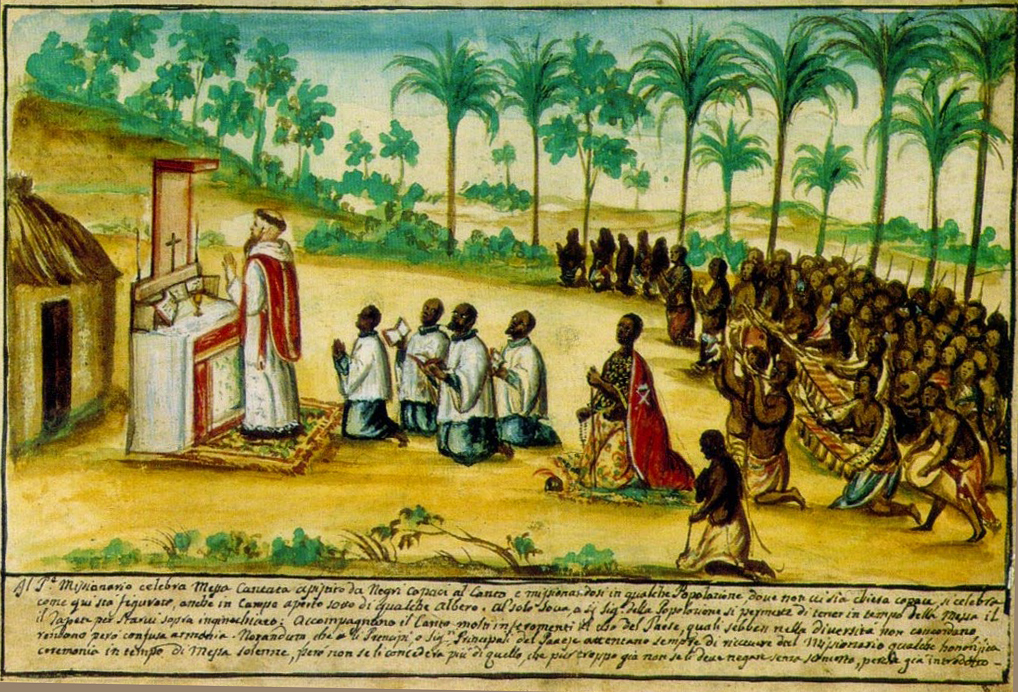
He told the Portuguese King that the slavers were “ruining our kingdom and the Christianity which has been established here for so many years and which cost your predecessors so many sacrifices.” He appealed to the king’s missionary impulse to provide “this great blessing of faith” to new peoples–and said he was anxious to preserve that faith intact in the Congo. But:
“…European goods exert such a fascination over the simple and the ignorant that they leave God in order to obtain them…The lure of profit and greed lead the people of the land to rob their compatriots, including members of their own family and of ours, without considering whether they are Christians or not. They capture them, sell them, barter them. This abuse is so great that we cannot correct it without striking hard and harder.”
From our 21st century vantage point, it is easy to posture and preen in imperious judgment of men long since dead, and to force complex historical circumstances into boilerplate soundbites and stale 19th century political theories. We conveniently imagine ourselves on the right side and hardly dare ask what fascinating merchandise and bits of modern technology we’ve traded God for.
Afonso, however, who saw the birth of the Atlantic Slave Trade before his very eyes, was not interested in cheap virtue signaling.
Whether he was defending his succession against pagan relatives or defending his kingdom against a Christian foreigner, whether he was inveighing against the hypocritical greed of Christian traders or the heartbreaking selfishness of his own people, one thing seems fairly consistent in his rhetoric: a fidelity to God’s law.
King Afonso I of Kongo died in 1542, unable to snuff out the slave trade in its infancy. In ensuing years, it would metastasize into an intercontinental nightmare that would see some 10-12 million Africans brought across the Atlantic in chains, over a million of them perishing along the way. It is not hard to imagine what the writer of those letters would have felt about the future, had he lived to see it.
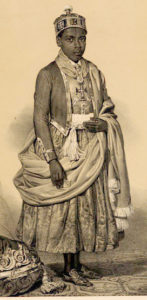 Because of the precedents Afonso established, the Kingdom of Kongo was set on a religious course that it maintained for centuries afterward. His successors were duly recognized as Catholic Monarchs by the Pope and the Royal Houses of Europe, who extended to the African nobility such European titles as Count and Duke. The kingdom would, however, continue to be beset by internal dissension and external conflict until it was weakened and finally abolished in 1914, during a decade that proved fatal to so many of the ancient monarchies of Christendom.
Because of the precedents Afonso established, the Kingdom of Kongo was set on a religious course that it maintained for centuries afterward. His successors were duly recognized as Catholic Monarchs by the Pope and the Royal Houses of Europe, who extended to the African nobility such European titles as Count and Duke. The kingdom would, however, continue to be beset by internal dissension and external conflict until it was weakened and finally abolished in 1914, during a decade that proved fatal to so many of the ancient monarchies of Christendom.
Afonso, like Constantine, is not ultimately to be judged by the miraculous events that surrounded his accession, the geopolitical situation he navigated, or even the longevity of his nation. He is to be judged–as all of us are–by one thing alone: how did he respond to the graces that God gave him?
It is not for history to answer that question. But there is good reason for the Catholics of today, particularly those descended from his subjects, to admire this loyal son of Holy Mother Church who forged an island of Christendom in the heart of the Congo.
July 10, 2020

A True Roman: Morricone on Gregorian Chant
On Monday renowned Italian film composer Ennio Morricone passed into eternal life con il conforto della fede (with the comfort of faith), one day before the 13th anniversary of Pope Benedict XVI’s Summorum Pontificum.
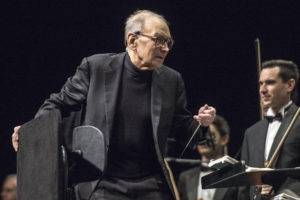
Morricone produced some beautifully haunting, exquisite melodies in films like The Mission and Cinema Paradiso. But he was popularly known for bizarre but irresistible Western themes like The Good, the Bad, and the Ugly, assembled from an improbable mix of howls, ocarinas, and whistles. He also composed a small body of sacred works. But frankly, his most noted one, the Missa Papae Francisci, is not suited for liturgical use and seems more appropriate for a trippy György-Ligeti-style journey through a stargate, à la 2001:A Space Odyssey (which, coincidentally, Stanley Kubrick had wanted him to score).
Notwithstanding Morricone’s unusual experimental style and (musical) modernism, he had a true sense of beauty and a genuine love for the music of the classical Roman liturgy.
In a 2010 interview with Edward Pentin, the composer expressed a great deal of respect for Pope Benedict XVI, “a very high-minded Pope who has a great culture and also great strength,” and offered some frank thoughts about the state of music in the Church:
He has a great wish to correct [liturgical] errors that have existed and continue to exist, and he tried to fix them just a few days after being elected. Today, the Church has made a big mistake, turning the clock back 500 years with guitars and popular songs. I don’t like it at all. Gregorian chant is a vital and important tradition of the Church, and to waste this by having guys mix religious words with profane Western songs is hugely grave, hugely grave. The same thing happened before the Council of Trent, when singers sang profane songs with sacred melodies and sacred words. He [the Pope] is doing well to correct it. He should correct it with much more firmness. Some churches have taken heed [of his corrections], but others haven’t.
Morricone was neither a traditionalist nor a critic of the entire postconciliar enterprise. He just knew music. It was his life. And when he saw a reckless liturgical revolution threaten to overturn his beloved art, he suddenly lost any room for toleration:
But I don’t agree with, and feel very strongly about, mixing profane, secular music with religious words in Church, or mixing religious music with a profane and secular text. After the Second Vatican Council, I was asked to be a consultor to the vicariate for two pieces of sung Church music, and I refused. The Church and Christians have Gregorian chant, and they said we had to now have this other music, so I refused. All the musicians in Rome also refused to work with it.
In a subsequent 2016 interview, Morricone described being “very unhappy” when the Church began to detach itself from Gregorian chant, which, he insisted
“was essential in Western music. Year zero — if it had not begun from there, polyphony, counterpoint, harmony, the first forms of “sacred” music would probably not have been developed … Gregorian chant is linked to the history of our European culture and constitutes its important musical roots.”
Indeed, out of all the arts, music is somewhat odd in that its history begins in the West not with the classical period of Greece and Rome but with the early medievals and the Church. This is mostly because very little ancient music has been preserved. And what little does remain hasn’t been reverently kept at the forefront of Western culture in the way that, say, the Odyssey or the Aeneid has–or the chants of the Missale Romanum.
So as we remember this week how the 2007 promulgation of Summorum Pontificum gloriously vindicated that most ancient Roman Mass and the vast body of Gregorian chant proper to it that underpins all of Western music, we would do well to spare a few moments in prayer for a talented Roman composer who defended their preservation.
Requiem aeternam dona ei, Domine, et lux perpetua luceat ei.
July 8, 2020

Meménto and Prayer Card Online Editions
Did you know that our monthly newsletter Meménto is now available in an easily accessible online edition? You’ll find the same great articles and news about Fraternity apostolates in a readable flipbook format.
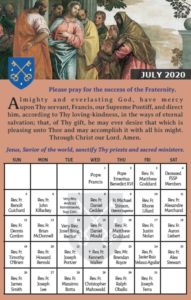 And we’ve also made our monthly prayer card for priests available online, so you can access it instantly via desktop or mobile. No need to worry about misplacing a card–it’s right on your phone, wherever you go. And you can even download a printable pdf of the card–print out as many copies as you like, place them in your missals and prayer books, or give them away at your parish.
And we’ve also made our monthly prayer card for priests available online, so you can access it instantly via desktop or mobile. No need to worry about misplacing a card–it’s right on your phone, wherever you go. And you can even download a printable pdf of the card–print out as many copies as you like, place them in your missals and prayer books, or give them away at your parish.
Bookmark the new pages, or you can also access these publications through our navigation menu under Media and News.


Support the Meménto newsletter.
July 6, 2020

Here’s to a Great Story
by Rachel Shrader
Happy Independence Day! Our country’s 244th birthday gives us an opportunity to pause and reflect on the many blessings that God has bestowed upon us as Americans. It seems fitting that this day has come upon us in the midst of the national turmoil surrounding the vandalization of monuments and the demonization of many figures from our history. For us as Catholics, it has been particularly grievous to see some of our own saints targeted.
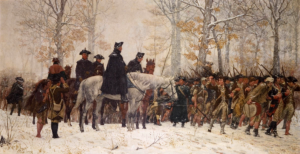
I for one love the American story, and that sentiment does not spring only from patriotism, nor from a naïve notion that our story is anywhere near perfect. I love it because it’s a great story. All day long I could listen to the tale of how a bunch of underdog, rag-tag rebels ousted an empire and started an experiment based on the idea that all men are created equal, that they have a dignity as children of God that no one can take from them. It’s too far-fetched. You couldn’t write this stuff. How on earth did those Americans do it? How did they win, how did they reconstruct after a brutal civil war? What about Gettysburg? How did those Normandy landings happen? Let’s hear the story again. And again and again and again.
So, on this anniversary of the adoption of the Declaration of Independence, I contend that our country boasts a great company of men and women – many of them Catholic – who accomplished extraordinary things to build up these United States of America. As an antidote to the misinformation and anger currently reigning in the public square, I invite you to join me in a toast to some of my favorite Catholic characters from the American story and to the beautiful country they helped create.
St. Junípero Serra
Born on the island of Mallorca, Spain, in 1713, St. Junípero was educated by the Franciscans, joined the  order at the age of 16 and was later ordained a priest. Intellectually gifted, he achieved a high level of education and worked as a professor and academic for many years. But his heart yearned for missionary work, and at the age of 35, he left his successful life behind and set sail for Mexico, landing at Vera Cruz and walking 250 miles on foot with a companion to Mexico City. During the journey St. Junípero sustained an injury to his leg that would plague him the rest of his life.
order at the age of 16 and was later ordained a priest. Intellectually gifted, he achieved a high level of education and worked as a professor and academic for many years. But his heart yearned for missionary work, and at the age of 35, he left his successful life behind and set sail for Mexico, landing at Vera Cruz and walking 250 miles on foot with a companion to Mexico City. During the journey St. Junípero sustained an injury to his leg that would plague him the rest of his life.
After 18 years as a missionary in central Mexico and the Baja peninsula, he set off for modern-day California, where he founded missions that would become some of California’s most famous cities, such as San Diego and San Francisco. He fought for the just treatment of the Native Americans at the missions, traveling all the way back to Mexico City in 1773 to defend their rights before the Viceroy.
Leg injury and all, the indefatigable “Apostle of California” walked thousands of miles during his life to spread the Faith and care for the faithful of the missions, and he died at Mission San Carlos Borromeo in 1784.
St. Frances Xavier Cabrini
St. Frances is the first United States citizen to be canonized. She hailed from a small town near Milan, Italy 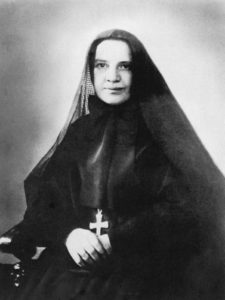 and spent the first part of her life in her home country, founding the Missionary Sisters of the Sacred Heart of Jesus with seven other sisters in 1880. She dreamed of undertaking missionary work in China, but Pope Leo XIII recommended that, instead of going east to China, she head west – to the United States. She and her sisters arrived in New York City to work among the Italian immigrants there, and they founded schools, a hospital, orphanages and organized catechism and education classes.
and spent the first part of her life in her home country, founding the Missionary Sisters of the Sacred Heart of Jesus with seven other sisters in 1880. She dreamed of undertaking missionary work in China, but Pope Leo XIII recommended that, instead of going east to China, she head west – to the United States. She and her sisters arrived in New York City to work among the Italian immigrants there, and they founded schools, a hospital, orphanages and organized catechism and education classes.
The work of the sisters spread far beyond the borders of New York. St. Frances founded 67 institutions in New York City, Chicago, elsewhere in the United States and in Latin America and Europe.
St. Kateri Tekakwitha
St. Kateri’s mother was a Catholic Algonquin and her father a chief of the Mohawk. When she was a child, 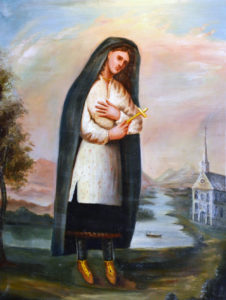 her village suffered a smallpox epidemic, which took the lives of her parents and little brother, scarred her face and impaired her eyesight. In her village she heard the preaching of the “Blackrobes” – the Jesuit missionaries who worked in New York and Canada, the most famous of whom, St. Isaac Jogues and his companions, had been martyred soon before her birth. She was baptized and eventually traveled 200 miles on foot to Sault Saint-Louis, a Christian Indian village near Montréal, to remove herself from the persecution she faced in her own village. She took a vow of virginity and lived her life in prayer and penance, going to her reward in 1680 at the age of 24. At her death, witnesses say that the scars on her face disappeared and her face became like that of a healthy young woman. She is called the “Lily of the Mohawk” and was canonized in 2012, the first Native American to become a saint.
her village suffered a smallpox epidemic, which took the lives of her parents and little brother, scarred her face and impaired her eyesight. In her village she heard the preaching of the “Blackrobes” – the Jesuit missionaries who worked in New York and Canada, the most famous of whom, St. Isaac Jogues and his companions, had been martyred soon before her birth. She was baptized and eventually traveled 200 miles on foot to Sault Saint-Louis, a Christian Indian village near Montréal, to remove herself from the persecution she faced in her own village. She took a vow of virginity and lived her life in prayer and penance, going to her reward in 1680 at the age of 24. At her death, witnesses say that the scars on her face disappeared and her face became like that of a healthy young woman. She is called the “Lily of the Mohawk” and was canonized in 2012, the first Native American to become a saint.
Servant of God Chaplain Emil Kapaun
Born in the Czech farming community of Pilsen, Kansas, in 1916, Fr. Kapaun was ordained for the 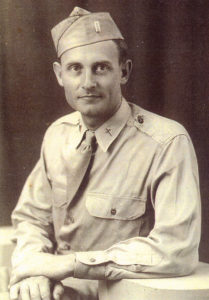 Diocese of Wichita in 1940, joining the U.S. Army Chaplain Corps in 1944 and serving in the Burma-India theater of World War II. After earning his Master’s degree and doing pastoral work in Kansas, he returned to military service in 1948 by his own request. As a chaplain in the Korean War he was fearless in his duties, celebrating Mass on the battlefield, administering the sacraments, retrieving the wounded and burying the dead. He received the Bronze Star for bravery in action on August 2nd, 1950, after rescuing a wounded man despite intense enemy fire.
Diocese of Wichita in 1940, joining the U.S. Army Chaplain Corps in 1944 and serving in the Burma-India theater of World War II. After earning his Master’s degree and doing pastoral work in Kansas, he returned to military service in 1948 by his own request. As a chaplain in the Korean War he was fearless in his duties, celebrating Mass on the battlefield, administering the sacraments, retrieving the wounded and burying the dead. He received the Bronze Star for bravery in action on August 2nd, 1950, after rescuing a wounded man despite intense enemy fire.
But the actions that would earn him the Medal of Honor, our country’s highest military award for valor, occurred during and after the Battle of Unsan on November 1st-2nd, 1950. After his group was attacked, Chaplain Kapaun intrepidly ran about the battlefield, administering last rites and dragging the wounded to safety. Offered the chance to escape, he and a medic chose to stay with the wounded, and eventually he and his comrades were captured and marched to Prison Camp No. 5, 60-100 miles away.
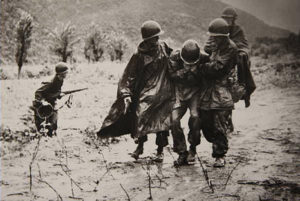
In the midst of the horrendous conditions at the camp, Chaplain Kapaun tirelessly dedicated himself to the spiritual and physical care of the suffering soldiers. Though public prayers were forbidden, he snuck around to the various huts after dark to pray with the men and, defying orders, led them in an Easter service in 1951.
He fell ill not long after, and his captors transferred him to the camp “hospital” – in reality, a place where they left people to die. His men insisted on carrying him there themselves, and he forgave and blessed his captors as he went. He died alone in the hospital a few days later, only 35 years old. When the camp was liberated two and a half years later, his men made sure the story of their heroic chaplain was known.
I wish I had space here to bring you more tales of those who helped shape our country and provided her with some of her finest examples of courage, self-sacrifice and love for others. A few that I recommend researching if you don’t know about them: Fr. Pierre-Jean De Smet, St. Katharine Drexel, St. John Neumann…the list goes on. Like the men of Prison Camp No. 5, let us go forth and share the stories of our saints, that their heroism may inspire us to continue the great work they began. Tell these great tales to all the world, and when you’re done, I’ll want to hear them again. And again and again and again. +
Rachel Shrader was the editor and primary writer of the Missive from its inception in June 2017 until May 2020. She now contributes as a freelance writer, covering military topics, the international work of the FSSP, and FSSP parish life.
July 4, 2020


